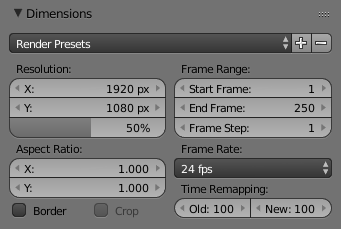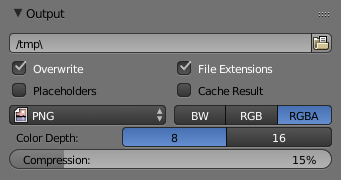Output Options¶
The first step in the rendering process is to determine and set the output options. This includes render size, frame rate, pixel aspect ratio, output location, and file type.
Dimensions panel¶

Dimensions Panel.
- Render Presets
- Common format presets for TVs and screens.
- Resolution
- X/Y
- The number of pixels horizontally and vertically in the image.
- Percentage
- Slider to reduce or increase the size of the rendered image relative to the X/Y values above. This is useful for small test renders that are the same proportions as the final image.
- Aspect Ratio
Older televisions may have non-square pixels, so this can be used to control the shape of the pixels along the respective axis. This will pre-distorted the images which will look stretched on a computer screen, but which will display correctly on a TV set. It is important that you use the correct pixel aspect ratio when rendering to prevent re-scaling, resulting in lowered image quality.
See Video Output for details on pixel aspect ratio.
- Border
You can render just a portion of the view instead of the entire frame. While in Camera View, press
Ctrl-Band drag a rectangle to define the area you want to render.Ctrl-Alt-Bis the shortcut to disable the border.Note
This disables the Save Buffers option in Performance and Full Sample option in Anti-Aliasing.
Enabling Crop will crop the rendered image to the Border size, instead of rendering a black region around it.
- Frame Range
- Set the Start and End frames for Rendering Animations. Step controls the number of frames to advance by for each frame in the timeline.
- Frame Rate
- For an Animation the frame rate is how many frames will be displayed per second.
- Time Remapping
- Use to remap the length of an animation.
Output Panel¶

Output panel.
This panel provides options for setting the location of rendered frames for animations, and the quality of the saved images.
- File Path
Choose the location to save rendered frames.
When rendering an animation, the frame number is appended at the end of the file name with four padded zeros (e.g.
image0001.png). You can set a custom padding size by adding the appropriate number of#anywhere in the file name (e.g.image_##_test.pngtranslates toimage_01_test.png).This setting expands relative paths where a
//prefix represents the directory of the current blend-file.- Overwrite
- Overwrite existing files when rendering.
- Placeholders
- Create empty placeholder frames while rendering.
- File Extensions
- Adds the correct file extensions per file type to the output files.
- Cache Result
- Saves the rendered image and passes to a Multilayer EXR-file in temporary location on your hard drive. This allows the compositor to read these to improve performance, especially for heavy compositing.
- Output Format
- Choose the file format to save to. Based on which format is used, other options such as channels, bit-depth and compression level are available.
Hint
Primitive Render-Farm
An easy way to get multiple machines to share the rendering workload is to:
- Set up a shared directory over a network file-system.
- Disable Overwrite, enable Placeholders in the Render Output panel.
- Start as many machines as you wish rendering to that directory